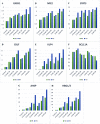The effect of histone deacetylase inhibitors on AHSP expression
- PMID: 29389946
- PMCID: PMC5794076
- DOI: 10.1371/journal.pone.0189267
The effect of histone deacetylase inhibitors on AHSP expression
Abstract
Alpha-hemoglobin stabilizing protein (AHSP) is a molecular chaperone that can reduce the damage caused by excess free α-globin to erythroid cells in patients with impaired β-globin chain synthesis. We assessed the effect of sodium phenylbutyrate and sodium valproate, two histone deacetylase inhibitors (HDIs) that are being studied for the treatment of hemoglobinopathies, on the expression of AHSP, BCL11A (all isoforms), γ-globin genes (HBG1/2), and some related transcription factors including GATA1, NFE2, EKLF, KLF4, and STAT3. For this purpose, the K562 cell line was cultured for 2, 4, and 6 days in the presence and absence of sodium phenylbutyrate and sodium valproate. Relative real-time qRT-PCR analysis of mRNA levels was performed to determine the effects of the two compounds on gene expression. Expression of all target mRNAs increased significantly (p < 0.05), except for the expression of BCL11A, which was down-regulated (p < 0.05) in the cells treated with both compounds relative to the levels measured for untreated cells. The findings indicated that sodium valproate had a more considerable effect than sodium phenylbutyrate (p < 0.0005) on BCL11A repression and the up-regulation of other studied genes. γ-Globin and AHSP gene expression continuously increased during the culture period in the treated cells, with the highest gene expression observed for 1 mM sodium valproate after 6 days. Both compounds repressed the expression of BCL11A (-XL, -L, -S) and up-regulated GATA1, NFE2, EKLF, KLF4, STAT3, AHSP, and γ-globin genes expression. Moreover, sodium valproate showed a stronger effect on repressing BCL11A and escalating the expression of other target genes. The findings of this in vitro experiment could be considered in selecting drugs for clinical use in patients with β-hemoglobinopathies.
Conflict of interest statement
Figures



Similar articles
-
Alterations in expression and chromatin configuration of the alpha hemoglobin-stabilizing protein gene in erythroid Kruppel-like factor-deficient mice.Mol Cell Biol. 2006 Jun;26(11):4368-77. doi: 10.1128/MCB.02216-05. Mol Cell Biol. 2006. PMID: 16705186 Free PMC article.
-
Relationship between AHSP gene expression, β/α globin mRNA ratio, and clinical severity of the β-thalassemia patients.Ann Clin Lab Sci. 2014 Spring;44(2):189-93. Ann Clin Lab Sci. 2014. PMID: 24795058
-
Therapeutic fetal-globin inducers reduce transcriptional repression in hemoglobinopathy erythroid progenitors through distinct mechanisms.Blood Cells Mol Dis. 2016 Jan;56(1):62-9. doi: 10.1016/j.bcmd.2015.10.004. Epub 2015 Oct 27. Blood Cells Mol Dis. 2016. PMID: 26603726 Free PMC article.
-
AHSP and beta-thalassemia: a possible genetic modifier.Hematology. 2005 Apr;10(2):157-61. doi: 10.1080/10245330500067280. Hematology. 2005. PMID: 16019463 Review.
-
Clinical and experimental applications of sodium phenylbutyrate.Drugs R D. 2011 Sep 1;11(3):227-49. doi: 10.2165/11591280-000000000-00000. Drugs R D. 2011. PMID: 21902286 Free PMC article. Review.
Cited by
-
Transient Improvement in Erythropoiesis Is Achieved Via the Chaperone AHSP With Early Administration of Propranolol in Burn Patients.J Burn Care Res. 2021 Mar 4;42(2):311-322. doi: 10.1093/jbcr/iraa150. J Burn Care Res. 2021. PMID: 32842148 Free PMC article.
-
Effects of valproic acid on histone deacetylase inhibition in vitro and in glioblastoma patient samples.Neurooncol Adv. 2019 Nov 12;1(1):vdz025. doi: 10.1093/noajnl/vdz025. eCollection 2019 May-Dec. Neurooncol Adv. 2019. PMID: 32642660 Free PMC article.
-
Alpha-hemoglobin-stabilizing protein (AHSP): a modulatory factor in β-thalassemia.Int J Hematol. 2020 Mar;111(3):352-359. doi: 10.1007/s12185-019-02806-8. Epub 2020 Jan 1. Int J Hematol. 2020. PMID: 31894534 Review.
References
-
- Kihm AJ, Kong Y, Hong W, Russell JE, Rouda S, Adachi K, et al. An abundant erythroid protein that stabilizes free [alpha]-haemoglobin. Nature. 2002;417(6890):758–63. http://www.nature.com/nature/journal/v417/n6890/suppinfo/nature00803_S1..... doi: 10.1038/nature00803 - DOI - PubMed
-
- Weiss MJ, Zhou S, Feng L, Gell DA, Mackay JP, Shi Y, et al. Role of alpha-hemoglobin-stabilizing protein in normal erythropoiesis and beta-thalassemia. Annals of the New York Academy of Sciences. 2005;1054:103–17. Epub 2005/12/13. doi: 10.1196/annals.1345.013 . - DOI - PubMed
-
- dos Santos CO, Zhou S, Secolin R, Wang X, Cunha AF, Higgs DR, et al. Population analysis of the alpha hemoglobin stabilizing protein (AHSP) gene identifies sequence variants that alter expression and function. American journal of hematology. 2008;83(2):103–8. Epub 2007/09/18. doi: 10.1002/ajh.21041 . - DOI - PubMed
-
- Lim WF, Muniandi L, George E, Sathar J, Teh LK, Gan GG, et al. alpha-Haemoglobin stabilising protein expression is influenced by mean cell haemoglobin and HbF levels in HbE/beta-thalassaemia individuals. Blood cells, molecules & diseases. 2012;48(1):17–21. Epub 2011/11/15. doi: 10.1016/j.bcmd.2011.10.002 . - DOI - PubMed
-
- Borgna-Pignatti C. Modern treatment of thalassaemia intermedia. British journal of haematology. 2007;138(3):291–304. Epub 2007/06/15. doi: 10.1111/j.1365-2141.2007.06654.x . - DOI - PubMed
MeSH terms
Substances
LinkOut - more resources
Full Text Sources
Other Literature Sources
Miscellaneous

